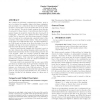Free Online Productivity Tools
i2Speak
i2Symbol
i2OCR
iTex2Img
iWeb2Print
iWeb2Shot
i2Type
iPdf2Split
iPdf2Merge
i2Bopomofo
i2Arabic
i2Style
i2Image
i2PDF
iLatex2Rtf
Sci2ools
COMPGEOM
2009
ACM
2009
ACM
Epsilon nets and union complexity
We consider the following combinatorial problem: given a set of n objects (for example, disks in the plane, triangles), and an integer L ≥ 1, what is the size of the smallest subset of these n objects that covers all points that are in at least L of the objects? This is the classic question about the size of an L n -net for these objects. It is well known that for fairly general classes of geometric objects the size of an L n -net is O( n L log n L ). There are some instances where this general bound can be improved, and this improvement is usually due to bounds on the combinatorial complexity (size) of the boundary of the union of these objects. Thus, the boundary of the union of m disks has size O(m), and this translates to an O( n L ) bound on the size of an L n -net for disks. For m fat triangles, the size of the union boundary is O(m log log m), and this yields L n -nets of size O( n L log log n L ). Improved nets directly translate into an upper bound on the ratio between the ...
| Added | 28 May 2010 |
| Updated | 28 May 2010 |
| Type | Conference |
| Year | 2009 |
| Where | COMPGEOM |
| Authors | Kasturi R. Varadarajan |
Comments (0)

